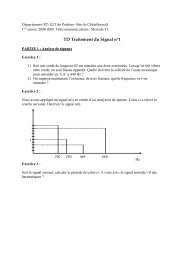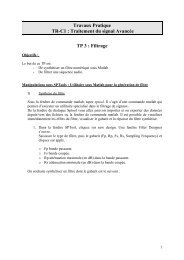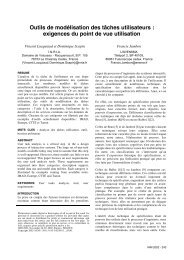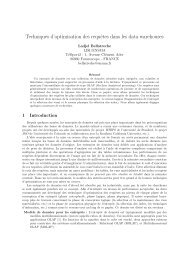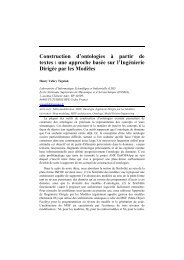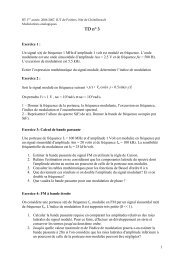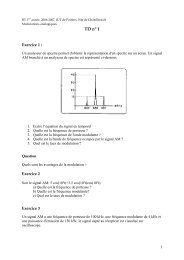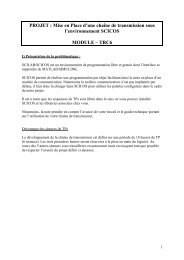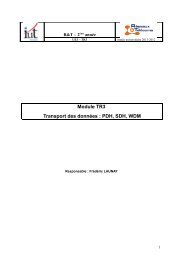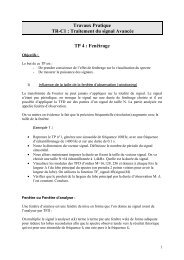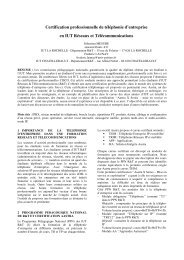Recursive subspace identification for in-flight modal ... - ResearchGate
Recursive subspace identification for in-flight modal ... - ResearchGate
Recursive subspace identification for in-flight modal ... - ResearchGate
You also want an ePaper? Increase the reach of your titles
YUMPU automatically turns print PDFs into web optimized ePapers that Google loves.
FLITE EUREKA 2 1575<br />
• Algorithm RPM2 tends to give more stabilized modes than EIVPM. In <strong>flight</strong> po<strong>in</strong>t #2, e.g., EIVPM<br />
only f<strong>in</strong>ds three stabilized modes, while RPM2 f<strong>in</strong>ds six.<br />
• Not every mode is detected <strong>in</strong> each <strong>flight</strong> po<strong>in</strong>t. For example, algorithm RPM2 f<strong>in</strong>ds a mode around<br />
6Hz <strong>in</strong> <strong>flight</strong> po<strong>in</strong>ts #1, #2 and #4, but not <strong>in</strong> <strong>flight</strong> po<strong>in</strong>ts #3 and #5.<br />
• Damp<strong>in</strong>g ratio estimates correspond<strong>in</strong>g to the same frequency sometimes differ much from <strong>flight</strong> po<strong>in</strong>t<br />
to <strong>flight</strong> po<strong>in</strong>t. For example, <strong>in</strong> <strong>flight</strong> po<strong>in</strong>t #3 the mode with frequency around 6.7Hz, identified by<br />
RPM2, has damp<strong>in</strong>g ratio 7.33%, while <strong>in</strong> <strong>flight</strong> po<strong>in</strong>t #4 it is only 1.26%.<br />
• It is not always easy to decide which mode <strong>in</strong> one <strong>flight</strong> po<strong>in</strong>t corresponds to which <strong>in</strong> another <strong>flight</strong><br />
po<strong>in</strong>t. It would be advantageous to track the frequencies and damp<strong>in</strong>gs <strong>in</strong> between the different <strong>flight</strong><br />
po<strong>in</strong>ts. This is exactly the aim of future <strong>in</strong>-<strong>flight</strong> tests, when also data will be measured dur<strong>in</strong>g the<br />
transition from one <strong>flight</strong> po<strong>in</strong>t to the follow<strong>in</strong>g.<br />
6.3 Computational speed<br />
In Figure 8 we show the time needed to process 96 new data po<strong>in</strong>ts as a function of time. Note that com stat<br />
only updates the model every 32 po<strong>in</strong>ts, while EIVPM and RPM2 do this every time a new data po<strong>in</strong>t is available.<br />
There<strong>for</strong>e, the blue circles <strong>in</strong> Figure 8 represent the computation cost <strong>for</strong> 3 updates of the com stat<br />
model and <strong>for</strong> 96 updates of the other two models. The computation time <strong>for</strong> com stat <strong>in</strong>creases l<strong>in</strong>early<br />
with time (i.e. with the number of data po<strong>in</strong>ts used <strong>for</strong> the <strong>identification</strong>). On the other hand, the time needed<br />
to update the models by means of the recursive methods, rema<strong>in</strong>s constant.<br />
It is clear from Figure 8 that the data can be processed <strong>in</strong> real-time. For com stat it might become more<br />
difficult when longer data sequences are given. In this case, memory problems could arise too. A solution<br />
<strong>for</strong> these problems could be to use a slid<strong>in</strong>g w<strong>in</strong>dow that discards the data po<strong>in</strong>ts that lie furthest <strong>in</strong> the past.<br />
The recursive algorithms EIVPM and RPM2 do not have these problems.<br />
Figure 8: The time needed to process 96 new data po<strong>in</strong>ts as a function of time. The black squares represent the time<br />
needed by RPM2 <strong>for</strong> 96 model updates, the magenta diamonds the computation time <strong>for</strong> 96 updates by EIVPM and the<br />
blue circles the time needed <strong>for</strong> 3 <strong>identification</strong>s by the non-recursive com stat.<br />
7 Conclusions and future work<br />
In this paper two recent recursive <strong>subspace</strong> <strong>identification</strong> algorithms are studied. Simulation examples show<br />
that the algorithms are able to track chang<strong>in</strong>g damp<strong>in</strong>g ratios, provided that <strong>for</strong> noisy measurements the<br />
<strong>for</strong>gett<strong>in</strong>g factor is chosen large enough (not much <strong>for</strong>gett<strong>in</strong>g). The algorithms are also applied to <strong>in</strong>-<strong>flight</strong><br />
measurements on an airplane. Us<strong>in</strong>g measurements from five <strong>flight</strong> po<strong>in</strong>ts, several modes (eigenfrequencies<br />
and damp<strong>in</strong>g ratios) of the airplane are identified. The computation time is short enough to apply the methods



